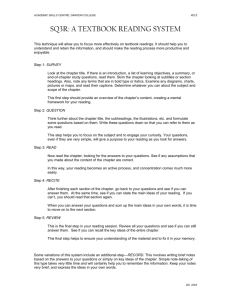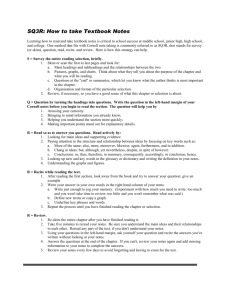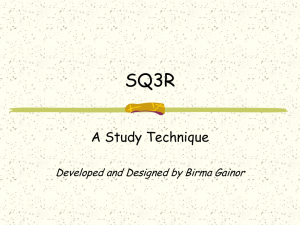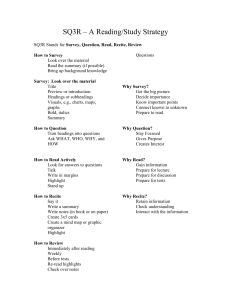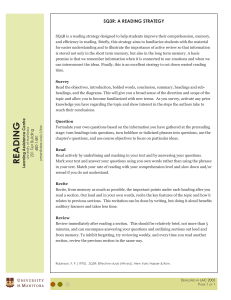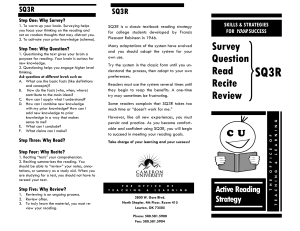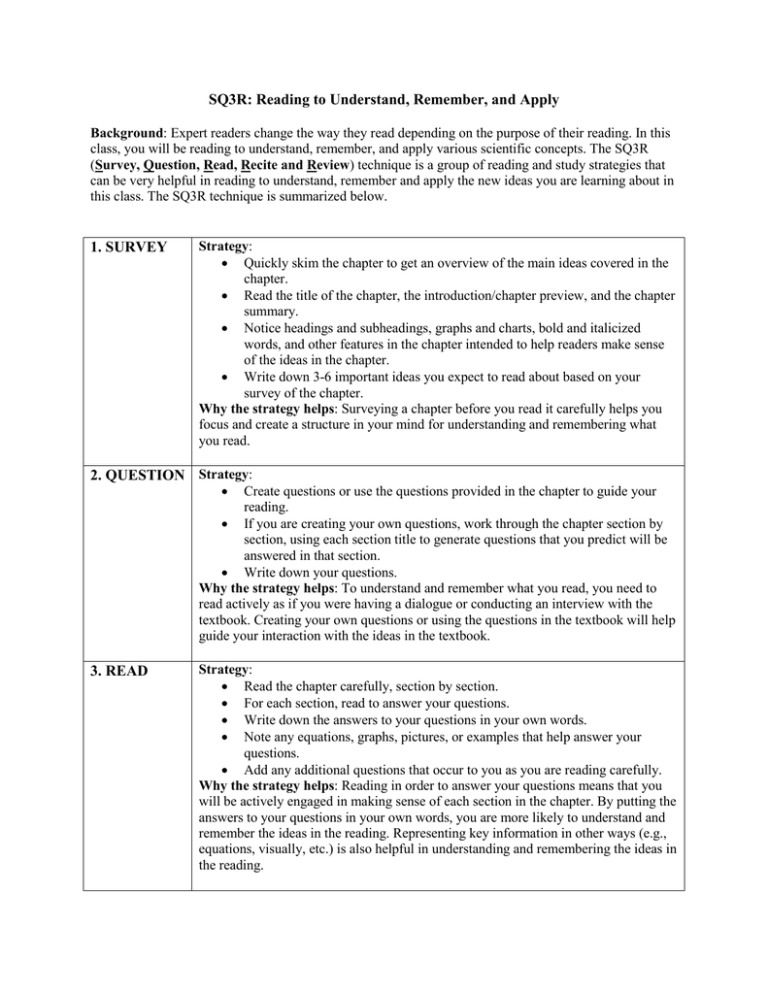
SQ3R: Reading to Understand, Remember, and Apply
Background: Expert readers change the way they read depending on the purpose of their reading. In this
class, you will be reading to understand, remember, and apply various scientific concepts. The SQ3R
(Survey, Question, Read, Recite and Review) technique is a group of reading and study strategies that
can be very helpful in reading to understand, remember and apply the new ideas you are learning about in
this class. The SQ3R technique is summarized below.
1. SURVEY
Strategy:
Quickly skim the chapter to get an overview of the main ideas covered in the
chapter.
Read the title of the chapter, the introduction/chapter preview, and the chapter
summary.
Notice headings and subheadings, graphs and charts, bold and italicized
words, and other features in the chapter intended to help readers make sense
of the ideas in the chapter.
Write down 3-6 important ideas you expect to read about based on your
survey of the chapter.
Why the strategy helps: Surveying a chapter before you read it carefully helps you
focus and create a structure in your mind for understanding and remembering what
you read.
2. QUESTION Strategy:
Create questions or use the questions provided in the chapter to guide your
reading.
If you are creating your own questions, work through the chapter section by
section, using each section title to generate questions that you predict will be
answered in that section.
Write down your questions.
Why the strategy helps: To understand and remember what you read, you need to
read actively as if you were having a dialogue or conducting an interview with the
textbook. Creating your own questions or using the questions in the textbook will help
guide your interaction with the ideas in the textbook.
3. READ
Strategy:
Read the chapter carefully, section by section.
For each section, read to answer your questions.
Write down the answers to your questions in your own words.
Note any equations, graphs, pictures, or examples that help answer your
questions.
Add any additional questions that occur to you as you are reading carefully.
Why the strategy helps: Reading in order to answer your questions means that you
will be actively engaged in making sense of each section in the chapter. By putting the
answers to your questions in your own words, you are more likely to understand and
remember the ideas in the reading. Representing key information in other ways (e.g.,
equations, visually, etc.) is also helpful in understanding and remembering the ideas in
the reading.
4. RECITE
Strategy:
Stop after each section. Cover up your written answers and recite the answers
to yourself (or your study group).
If you can’t answer the questions without looking at your answers or the
textbook, review your answers and the textbook, and try again until you can
recite the answers.
Why the strategy helps: When you are learning new ideas, you need to monitor your
understanding of those new ideas. Reciting the answers to your questions helps you
identify what you understand and where the gaps are in your understanding.
Meaningful repetition of new ideas also makes it more likely that you will remember
the new ideas and make them part of the knowledge structures in your mind.
5. REVIEW
Strategy:
Right after completing steps 2-4 above for each section, review your
questions for the entire chapter.
If you find that there are some questions you cannot answer without looking
at your written answers, re-read the section(s) where you found the answers.
Continue to review at regular intervals.
Why the strategy helps: New ideas that are not reviewed are quickly forgotten.
SQ3R Template
If you are keeping an SQ3R reading log/journal for this class, please use the following template
for your reading log/journal.
Top of Page 1: Chapter Title
Page 1
Note 3-6 main ideas based on your survey of
the chapter.
For each section,
As you read each
write down your
section, write down
questions in this
the answers to your
column.
questions in this
column.
Page 2
As you read each section, note key equations,
graphs, pictures, or examples in this column.
References
Brown, H. D. (2007). Teaching by principles (3rd ed.). White Plains, NY: Pearson/Longman.
Ghoston, M. R. (2004). SQ3R: A reading and study skills system. Retrieved from
http://www.ucc.vt.edu/stdysk/sq3r.html
Robinson, F. P. (1970). Effective study (4th ed.). New York, NY: Harper and Row.

